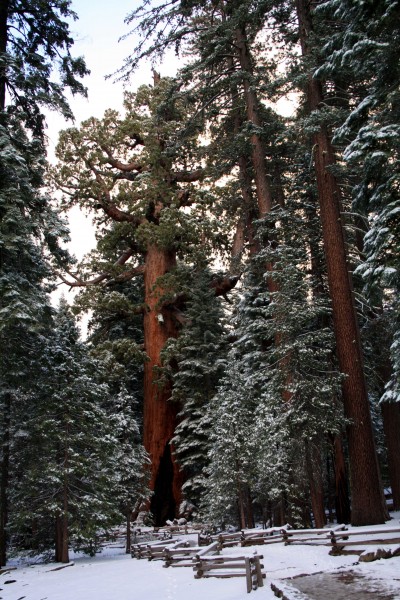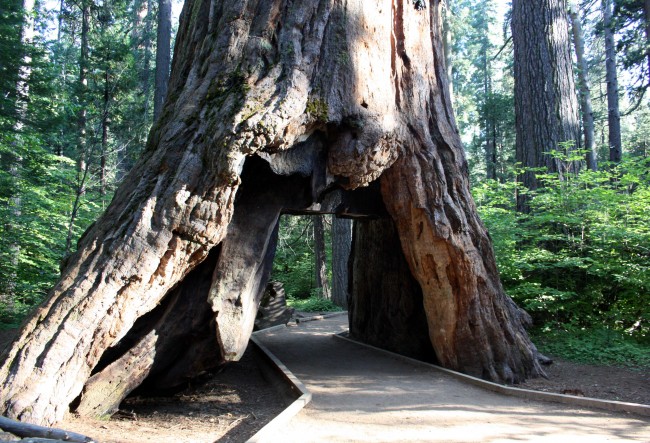Calaveras Big Trees
Photo by adam blauert
The wonder of the Big Trees
A shady grove of giant sequoias is a great place to be during the hot months of summer. Naturally-occurring populations of giant sequoias – scientific name Sequoiadendron giganteum, also known as Sierra redwoods – are found only along the western slope of our Sierra Nevada mountains.
These massive trees can grow to be over 300 feet tall and 100 feet in circumference, and can live for as many as 3,500 years.
Out of about 70 total groves of these amazing trees, only 9 are located north of the Kings River. Close to home, Yosemite’s spectacular Mariposa Grove is probably the best-known, with 500 mature sequoias.
During the summer it can be enjoyed on foot or by taking one of the tram tours offered by the park. Two smaller groves within the park, the Merced and the Tuolumne, are accessed from easy trails along the Tioga Road (Highway 120).
Highway 4
Another great place to see sequoias is Calaveras Big Trees State Park, located four miles east of Arnold on Highway 4. Distance-wise, the drive from Merced is only about 10 miles longer than the drive to Yosemite’s Mariposa Grove.
While Yosemite’s Mariposa Grove is a must-see while you’re in Yosemite, one of the disadvantages is that you can’t actually camp there. At Calaveras Big Trees, you’ll find 74 comfortable sites with flush toilets and coin-operated showers right next to the North Grove.
Camping in the Big Trees
The campground is so close to the grove that you can start your hike through the trees directly from your campsite. An additional 55 sites are located at Oak Hollow, halfway between the two groves.
A small number of more primitive “environmental campsites” are also available throughout the park.
The campsites at Big Trees are often much easier to book than sites within Yosemite.
The North Grove is one of two groves that make up the park. Located on the north side of North Fork of the Stanislaus River, it is the most popular of the two.
Much of this is due to the fact that the trail is accessible to just about everyone – wheelchairs and strollers are commonly seen – and you can see a lot in an easy 1.5 mile loop.
Big Stump
One of the most memorable landmarks along the trail is the “big stump,” of the “Discovery Tree.” Cut down in the 1850’s, the stump was sanded smooth and used as a dance floor.
Today’s guests can stand on it to get an idea of just how massive these trees can be.
Tunnel cut through a Big Tree
Further along the trail, the “Pioneer Cabin Tree” has a tunnel cut through it and is one of the most photographed trees in the park.
The trees of this grove were the first giant sequoias discovered by European-American settlers that the general public came to know about.
They immediately became a popular tourist destination.
The South Grove is located on the opposite side of the Stanislaus, a few miles down the Walter W. Smith Memorial Parkway.
Hiking
For a longer hike, this grove’s 5-mile loop trail will satisfy. Along the way you’ll see the Agassiz Tree, the park’s largest. 262 feet tall and almost 100 feet in circumference, it is an amazing sight.
A number of longer trails and unpaved fire roads connect major parts of the park, allowing longer hikes.
For a different landscape, try the 2.5 mile Lava Bluffs Trail above the river.
In addition to hiking and camping, the park provides picnic areas and the river is open to fishing and swimming.
Day use is $8 a car
As a day trip or overnight camping destination, it is a great place to escape the summer heat.
It’s also a great place to visit year-round. The campground is open from March through November and the trails stay open in the snowy months for snowshoeing and cross-country skiing.
The park provides a safe place for kids to play in the snow. During a winter visit you can warm-up in the warming hut located at the North Grove.
In the fall maples, dogwoods, and shrubs can provide dramatic fall color among the evergreen sequoias, pines, and firs.
More information
The park’s website provides a lot of useful information for planning a trip.
Go to http://www.parks.ca.gov/?page_id=551
for more information or call the park at (209) 795-2334.
To book a campsite reservation, go to http://www.reserveamerica.com/
or call 1-800-444-7275.
Campsites are $35 a night and can accommodate recreational vehicles.







Adam Blauert, a high school teacher and avid outdoors enthusiast, has dedicated the majority of his life to Merced County. His passions include fishing, backpacking, delving into local history, and exploring the wonders of the western states.